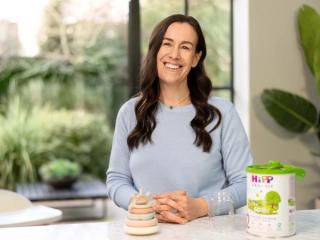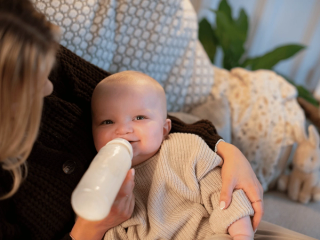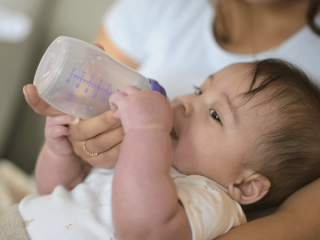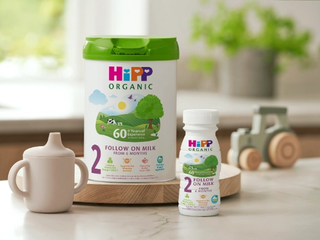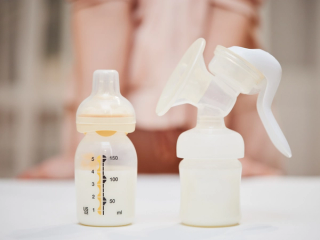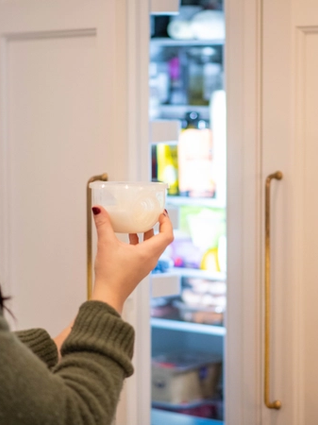
- Home
- Advice Hub
- Baby
- Baby Feeding
- Expressing And Storing Breast Milk
How to Express and Store Breast Milk
Learn how to express and store breast milk safely, maintain breastfeeding routines, and make feeding easier when you're away from your baby or sharing feeds.
There are many reasons why as a mum you may be considering expressing your breastmilk. You may need to be away from your baby but want to ensure you keep up your breastfeeding routines. It could be a return to work date, a social event or wanting to share feeding with a partner. This blog will walk you through the process and how to make this as easy as possible.
What is Breast Milk Expressing?
Breast milk expressing is the process of extracting milk from the breasts for later use. How you choose to do this is a personal preference, but it can be through hand expression or using a breast pump, which can be manual or electric. There are lots of variations in pumps that make this process easy and can suit your lifestyle, for example pumps you can use in a portable nature. This process allows you to store milk for later, relieve engorged breasts and boost milk supply.
Expressing Breast Milk by Pump
There are different types of breast pump and it is worth considering each one and what would be best for you and your lifestyle and comfort.
Manual Breast Pump
Manual pumps require you to create suction yourself by using a lever to express milk. While manual pumping can take longer than using an electric pump, it allows you to control the rhythm, it is a low-cost option and doesn’t require electricity.
Electric Breast Pump
Electric pumps use a motor to generate suction and express milk. Some need to be plugged into a wall outlet during use, while others have rechargeable batteries for portable convenience. Many electric pumps are double pumps, meaning they can express milk from both breasts simultaneously, making the process more efficient. If you are expressing for twins, double pumping can save you time as it maximises the amount of milk you can pump at once.
Wearable Breast Pump
Wearable pumps are chargeable and designed to fit discreetly inside a bra, allowing you to pump in public or on the go without drawing attention. These hands-free pumps enable multitasking, making them a convenient option for those managing a busy lifestyle while expressing milk.
Power pumping: Power pumping is a method of pumping for a short period of time (usually no longer than 15 minutes) at high frequency (usually every 2-3 hours). This technique can help increase milk production for mothers who have difficulty expressing enough milk.
Alternatives to breastmilk expressing
Hand expression of breast milk
This is a method of expressing milk by hand without the use of any devices. It can be done anywhere, at any time, and is great for relieving a bit of engorgement too. To hand express, cup your breast with your hand and use your thumb creating a C shape and first two fingers to press in and back towards the chest wall in a rhythmic motion. Milk will start to trickle out. If not, try doing this in a different area but do be gentle with yourself and your body. When the flow from one breast has slowed, swap to the other breast. Keep changing breasts until your milk drips very slowly or stops altogether.
If you are hand pumping always remember to keep things very clean to avoid the risk of bacteria build up
- Always wash your hands before handling any breastmilk
- To store, use a sterile container with a lid. You can also purchase disposable containers and bags
- Label any milk you are storing with dates so you know if it is still okay to use
- Always store your breastmilk in the fridge or freezer as soon as possible.
- Store at the back of the fridge and not in the door to ensure it is the right temperature
How to pump breastmilk efficiently
Pumping breastmilk can sometimes feel like a bit of a chore – especially when you are tired and already feeding a lot. With a little bit of planning and preparation, you can make pumping breastmilk more efficient and less time-consuming.
Here are some tips for how to pump breastmilk efficiently:
- Invest in a quality electric breast pump. This will save you time and energy compared to using a manual pump. Or a portable pump you can wear in your bra.
- Pump at regular intervals throughout the day. This will help maintain your milk supply and make pumping more efficient.
- Store your pumped milk in airtight containers in the fridge or freezer. This will help keep it fresh and prevent waste. Some pumps even enable you to pump directly into the storage bag, cup or bottle.
- Make sure you are comfortable before starting. In the early weeks you may want to pop a warm flannel on your breasts beforehand to help with milk flow.
- Use hands-on pumping techniques. Gently massaging your breasts while you pump can help increase milk production and flow, making pumping more efficient.
How to Safely Store Breastmilk
To ensure your breastmilk remains safe for your baby, it’s important to follow proper storage guidelines. Here are some key tips:
- You can store breastmilk in the fridge at 4°C or lower for up to 8 days. If you’re unsure of your fridge’s temperature or if it’s higher than 4°C, use the milk within 3 days. (You can buy fridge thermometers online to check.)
- You can also store breast milk In the freezer in an Ice compartment of a fridge for Up to 2 weeks and a freezer (-18°C or lower): Up to 6 months
- If you are on the go, breastmilk which has been cooled in the fridge can be transported in a cool bag with ice packs for up to 24 hours.
- Storage tips: To reduce waste, store breastmilk in small quantities. If freezing, always ensure you label and date the containers before storage.
How to defrost and heat up frozen breast milk?
When defrosting frozen breast milk, only defrost the amount your baby needs for one feeding, this is to avoid waste as any unused milk must be consumed within 24 hours or discarded. When heating up the breast milk avoid using hot water or microwaves, as they have the potential to destroy the delicate nutrients and antibodies in breast milk. Instead, you can run cold water over the frozen bag until it softens enough to pour into a bottle or, for best results, defrost it slowly in the fridge. Once thawed, warm the bottle under hot running water before feeding.
Remember, breast milk that has been defrosted should never be re-frozen.
Like every aspect of becoming a new parent, there is a lot to learn. Experimenting with different times and methods of breastmilk expression will help you understand what works best for you. Remember, there are always professionals available who are eager to support you with your feeding journey, so don’t hesitate to ask for help if you need guidance on expressing milk effectively.
FAQs About Breast Milk Expression and Storage
How long does breast milk keep in the fridge?
You can store breastmilk in the fridge at 4°C or lower for up to 8 days. If you’re unsure of your fridge’s temperature or if it’s higher than 4°C, use the milk within 3 days. (You can buy fridge thermometers online to check.)
Can I add freshly expressed breast milk to refrigerated milk?
Yes, if you chill freshly expressed milk before mixing it with other cooled milk. Adding freshly expressed milk risks raising the temperature of the chilled milk, increasing risk for bacteria to grow.
How much breast milk can be expressed at one time?
This varies, every mum is different and this depends on factors such as time since the last feed and your milk supply.
What happens if breast milk is not expressed?
Breast milk production is supply and demand, so if milk isn't removed regularly, the body will naturally produce less milk to match the demand. If your breasts are not emptied through breastfeeding or expressing, they can become painfully full and swollen due to milk build up and risk infection. Please note exclusively breastfeeding is perfectly fine on its own, you do not need to breastfeed, this is a choice.
How do I bring my milk home if I’ve expressed elsewhere?
If you are bringing expressed breast milk home, store it in a clean, sterile container, use a cooler bag with frozen ice packs to maintain a cold temperature. Once home, refrigerate the milk immediately.
